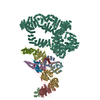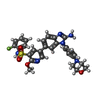+ Open data
Open data
- Basic information
Basic information
| Entry | Database: PDB / ID: 6bq1 | ||||||
|---|---|---|---|---|---|---|---|
| Title | Human PI4KIIIa lipid kinase complex | ||||||
 Components Components |
| ||||||
 Keywords Keywords | Transferase/Signaling Protein / kinase / phosphoinositide synthesis / Transferase-Signaling Protein complex | ||||||
| Function / homology |  Function and homology information Function and homology informationreorganization of cellular membranes to establish viral sites of replication / Synthesis of PIPs at the ER membrane / 1-phosphatidylinositol 4-kinase / 1-phosphatidylinositol 4-kinase activity / Synthesis of PIPs at the Golgi membrane / host-mediated perturbation of viral process / Golgi-associated vesicle membrane / phosphatidylinositol biosynthetic process / phosphatidylinositol-mediated signaling / phosphatidylinositol phosphate biosynthetic process ...reorganization of cellular membranes to establish viral sites of replication / Synthesis of PIPs at the ER membrane / 1-phosphatidylinositol 4-kinase / 1-phosphatidylinositol 4-kinase activity / Synthesis of PIPs at the Golgi membrane / host-mediated perturbation of viral process / Golgi-associated vesicle membrane / phosphatidylinositol biosynthetic process / phosphatidylinositol-mediated signaling / phosphatidylinositol phosphate biosynthetic process / myelination / protein localization to plasma membrane / neuron projection / cadherin binding / focal adhesion / signal transduction / extracellular exosome / ATP binding / membrane / plasma membrane / cytosol / cytoplasm Similarity search - Function | ||||||
| Biological species |  Homo sapiens (human) Homo sapiens (human) | ||||||
| Method | ELECTRON MICROSCOPY / single particle reconstruction / cryo EM / Resolution: 3.6 Å | ||||||
 Authors Authors | Lees, J.A. / Zhang, Y. / Oh, M. / Schauder, C.M. / Yu, X. / Baskin, J. / Dobbs, K. / Notarangelo, L.D. / Camilli, P.D. / Walz, T. / Reinisch, K.M. | ||||||
| Funding support |  United States, 1items United States, 1items
| ||||||
 Citation Citation |  Journal: Proc Natl Acad Sci U S A / Year: 2017 Journal: Proc Natl Acad Sci U S A / Year: 2017Title: Architecture of the human PI4KIIIα lipid kinase complex. Authors: Joshua A Lees / Yixiao Zhang / Michael S Oh / Curtis M Schauder / Xiaoling Yu / Jeremy M Baskin / Kerry Dobbs / Luigi D Notarangelo / Pietro De Camilli / Thomas Walz / Karin M Reinisch /  Abstract: Plasma membrane (PM) phosphoinositides play essential roles in cell physiology, serving as both markers of membrane identity and signaling molecules central to the cell's interaction with its ...Plasma membrane (PM) phosphoinositides play essential roles in cell physiology, serving as both markers of membrane identity and signaling molecules central to the cell's interaction with its environment. The first step in PM phosphoinositide synthesis is the conversion of phosphatidylinositol (PI) to PI4P, the precursor of PI(4,5)P and PI(3,4,5)P This conversion is catalyzed by the PI4KIIIα complex, comprising a lipid kinase, PI4KIIIα, and two regulatory subunits, TTC7 and FAM126. We here report the structure of this complex at 3.6-Å resolution, determined by cryo-electron microscopy. The proteins form an obligate ∼700-kDa superassembly with a broad surface suitable for membrane interaction, toward which the kinase active sites are oriented. The structural complexity of the assembly highlights PI4P synthesis as a major regulatory junction in PM phosphoinositide homeostasis. Our studies provide a framework for further exploring the mechanisms underlying PM phosphoinositide regulation. | ||||||
| History |
|
- Structure visualization
Structure visualization
| Movie |
 Movie viewer Movie viewer |
|---|---|
| Structure viewer | Molecule:  Molmil Molmil Jmol/JSmol Jmol/JSmol |
- Downloads & links
Downloads & links
- Download
Download
| PDBx/mmCIF format |  6bq1.cif.gz 6bq1.cif.gz | 821.2 KB | Display |  PDBx/mmCIF format PDBx/mmCIF format |
|---|---|---|---|---|
| PDB format |  pdb6bq1.ent.gz pdb6bq1.ent.gz | 649.9 KB | Display |  PDB format PDB format |
| PDBx/mmJSON format |  6bq1.json.gz 6bq1.json.gz | Tree view |  PDBx/mmJSON format PDBx/mmJSON format | |
| Others |  Other downloads Other downloads |
-Validation report
| Summary document |  6bq1_validation.pdf.gz 6bq1_validation.pdf.gz | 1003.4 KB | Display |  wwPDB validaton report wwPDB validaton report |
|---|---|---|---|---|
| Full document |  6bq1_full_validation.pdf.gz 6bq1_full_validation.pdf.gz | 1.1 MB | Display | |
| Data in XML |  6bq1_validation.xml.gz 6bq1_validation.xml.gz | 142 KB | Display | |
| Data in CIF |  6bq1_validation.cif.gz 6bq1_validation.cif.gz | 216.6 KB | Display | |
| Arichive directory |  https://data.pdbj.org/pub/pdb/validation_reports/bq/6bq1 https://data.pdbj.org/pub/pdb/validation_reports/bq/6bq1 ftp://data.pdbj.org/pub/pdb/validation_reports/bq/6bq1 ftp://data.pdbj.org/pub/pdb/validation_reports/bq/6bq1 | HTTPS FTP |
-Related structure data
| Related structure data |  7129MC M: map data used to model this data C: citing same article ( |
|---|---|
| Similar structure data |
- Links
Links
- Assembly
Assembly
| Deposited unit | 
|
|---|---|
| 1 |
|
- Components
Components
| #1: Protein | Mass: 173821.438 Da / Num. of mol.: 1 Source method: isolated from a genetically manipulated source Source: (gene. exp.)  Homo sapiens (human) / Gene: PI4KA, PIK4, PIK4CA / Production host: Homo sapiens (human) / Gene: PI4KA, PIK4, PIK4CA / Production host:  Homo sapiens (human) Homo sapiens (human)References: UniProt: P42356, 1-phosphatidylinositol 4-kinase | ||||||||||
|---|---|---|---|---|---|---|---|---|---|---|---|
| #2: Protein | Mass: 96460.570 Da / Num. of mol.: 2 Source method: isolated from a genetically manipulated source Source: (gene. exp.)  Homo sapiens (human) / Gene: TTC7B, TTC7L1 / Production host: Homo sapiens (human) / Gene: TTC7B, TTC7L1 / Production host:  Homo sapiens (human) / References: UniProt: Q86TV6 Homo sapiens (human) / References: UniProt: Q86TV6#3: Protein | Mass: 32688.514 Da / Num. of mol.: 2 Source method: isolated from a genetically manipulated source Source: (gene. exp.)  Homo sapiens (human) / Gene: FAM126A, DRCTNNB1A / Production host: Homo sapiens (human) / Gene: FAM126A, DRCTNNB1A / Production host:  Homo sapiens (human) / References: UniProt: Q9BYI3 Homo sapiens (human) / References: UniProt: Q9BYI3#4: Protein | | Mass: 173906.547 Da / Num. of mol.: 1 Source method: isolated from a genetically manipulated source Source: (gene. exp.)  Homo sapiens (human) / Gene: PI4KA, PIK4, PIK4CA / Production host: Homo sapiens (human) / Gene: PI4KA, PIK4, PIK4CA / Production host:  Homo sapiens (human) Homo sapiens (human)References: UniProt: P42356, 1-phosphatidylinositol 4-kinase #5: Chemical | Compound details | The sequence or connectivity could be assigned to the N-terminal residues of Entity-1 (PI4KA). They ...The sequence or connectivity could be assigned to the N-terminal residues of Entity-1 (PI4KA). They have been modeled as UNK residues | Sequence details | The actual sequence of the N-terminal region modeled as UNK is: ...The actual sequence of the N-terminal region modeled as UNK is: MDYKDHDGDY | |
-Experimental details
-Experiment
| Experiment | Method: ELECTRON MICROSCOPY |
|---|---|
| EM experiment | Aggregation state: PARTICLE / 3D reconstruction method: single particle reconstruction |
- Sample preparation
Sample preparation
| Component | Name: Human phosphatidylinositol 4-kinase III alpha complex / Type: COMPLEX / Entity ID: #1-#4 / Source: RECOMBINANT | |||||||||||||||||||||||||
|---|---|---|---|---|---|---|---|---|---|---|---|---|---|---|---|---|---|---|---|---|---|---|---|---|---|---|
| Molecular weight | Value: 0.7 MDa / Experimental value: NO | |||||||||||||||||||||||||
| Source (natural) | Organism:  Homo sapiens (human) Homo sapiens (human) | |||||||||||||||||||||||||
| Source (recombinant) | Organism:  Homo sapiens (human) / Cell: Expi293F Homo sapiens (human) / Cell: Expi293F | |||||||||||||||||||||||||
| Buffer solution | pH: 8 | |||||||||||||||||||||||||
| Buffer component |
| |||||||||||||||||||||||||
| Specimen | Conc.: 0.25 mg/ml / Embedding applied: NO / Shadowing applied: NO / Staining applied: NO / Vitrification applied: YES | |||||||||||||||||||||||||
| Specimen support | Grid material: COPPER / Grid mesh size: 400 divisions/in. / Grid type: Quantifoil R1.2/1.3 | |||||||||||||||||||||||||
| Vitrification | Instrument: FEI VITROBOT MARK IV / Cryogen name: ETHANE / Humidity: 90 % / Chamber temperature: 277 K |
- Electron microscopy imaging
Electron microscopy imaging
| Experimental equipment |  Model: Titan Krios / Image courtesy: FEI Company |
|---|---|
| Microscopy | Model: FEI TITAN KRIOS |
| Electron gun | Electron source:  FIELD EMISSION GUN / Accelerating voltage: 300 kV / Illumination mode: FLOOD BEAM FIELD EMISSION GUN / Accelerating voltage: 300 kV / Illumination mode: FLOOD BEAM |
| Electron lens | Mode: BRIGHT FIELD / Nominal magnification: 22500 X / Calibrated magnification: 38461 X / Nominal defocus max: 3500 nm / Nominal defocus min: 2000 nm / Calibrated defocus min: 1800 nm / Calibrated defocus max: 3700 nm / Cs: 2.7 mm / C2 aperture diameter: 100 µm / Alignment procedure: COMA FREE |
| Specimen holder | Cryogen: NITROGEN / Specimen holder model: FEI TITAN KRIOS AUTOGRID HOLDER |
| Image recording | Average exposure time: 10 sec. / Electron dose: 47 e/Å2 / Detector mode: SUPER-RESOLUTION / Film or detector model: GATAN K2 SUMMIT (4k x 4k) / Num. of real images: 3280 |
| Image scans | Movie frames/image: 40 / Used frames/image: 1-40 |
- Processing
Processing
| EM software |
| ||||||||||||||||||
|---|---|---|---|---|---|---|---|---|---|---|---|---|---|---|---|---|---|---|---|
| CTF correction | Type: PHASE FLIPPING AND AMPLITUDE CORRECTION | ||||||||||||||||||
| Particle selection | Num. of particles selected: 508504 | ||||||||||||||||||
| Symmetry | Point symmetry: C2 (2 fold cyclic) | ||||||||||||||||||
| 3D reconstruction | Resolution: 3.6 Å / Resolution method: FSC 0.143 CUT-OFF / Num. of particles: 64104 / Symmetry type: POINT |
 Movie
Movie Controller
Controller









 PDBj
PDBj





